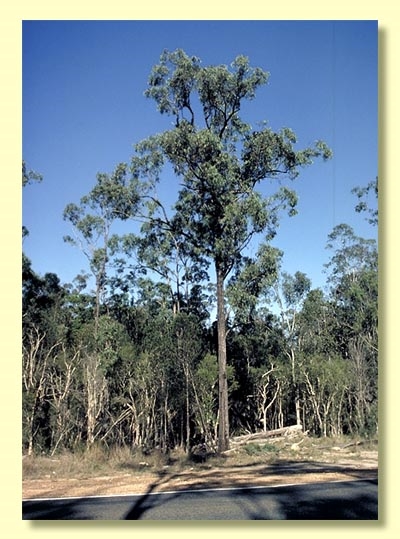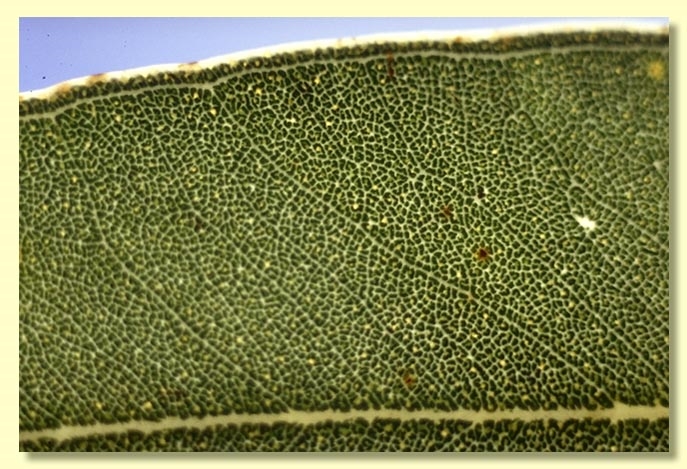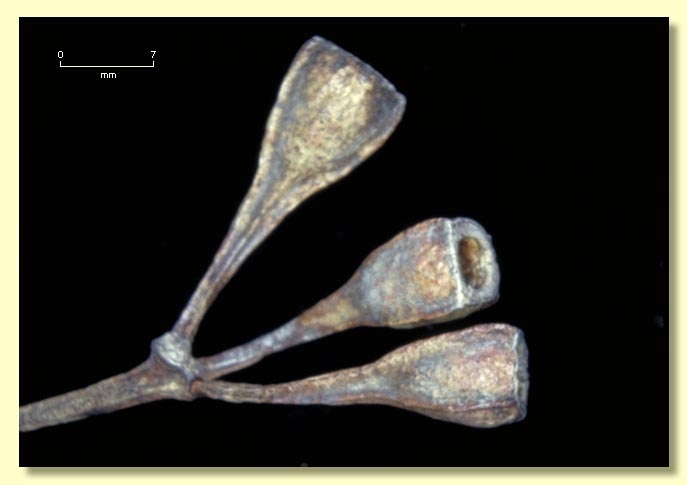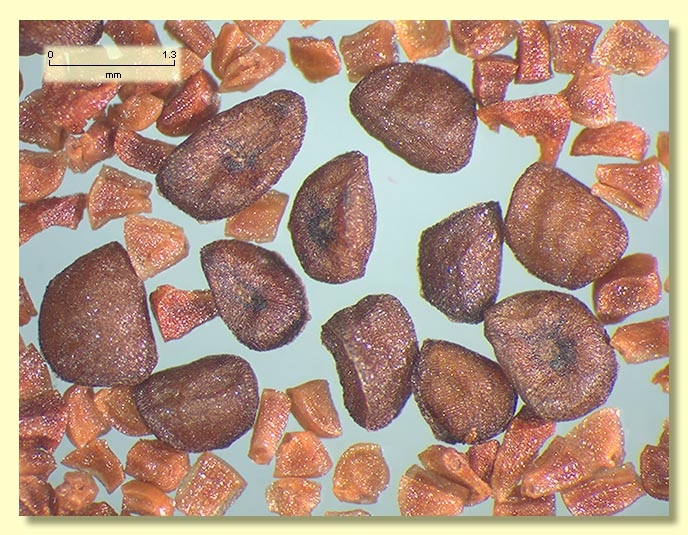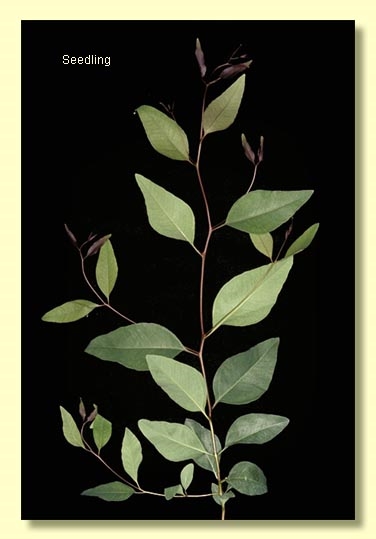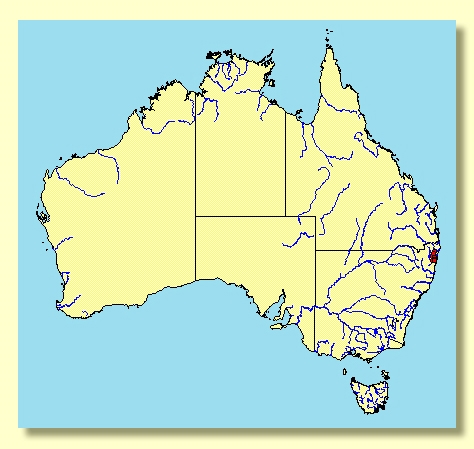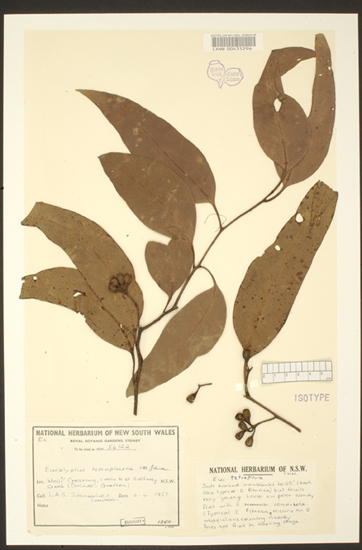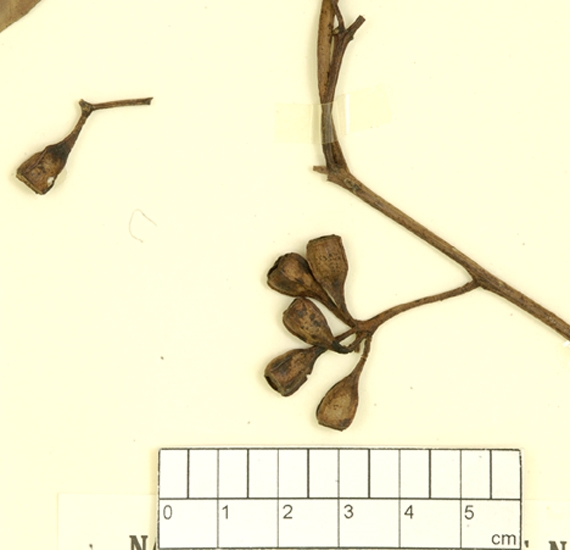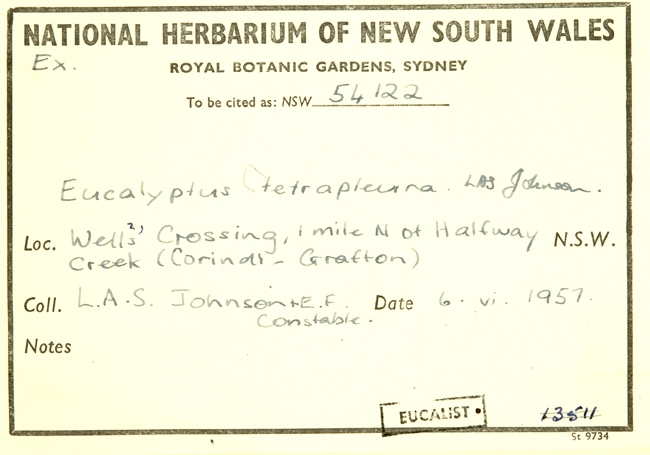Euclid - Online edition
Eucalyptus tetrapleura
Eucalyptus | Symphyomyrtus | Adnataria | Terminales | Rhodoxylon | Concolores
Ironbark to small branches, dark grey, thick and deeply furrowed.
Juvenile growth (coppice or field seedlings to 50 cm): stem square or rounded in cross-section; juvenile leaves always petiolate, opposite for about 5 to 7 nodes then alternate, ovate to lanceolate, 7–14.5 cm long, 2–6 cm wide, base tapering to petiole, dull, green.
Adult leaves alternate, petiole 1–3.1 cm long; blade lanceolate to falcate, 8–20 cm long, 1.7–3.4 cm wide, base usually tapering to petiole, concolorous, dull, green, side-veins greater than 45° to midrib, very densely reticulate, intramarginal vein parallel to and just within margin, oil glands intersectional or obscure.
Inflorescence terminal compound, sometimes compound in subterminal axils also, peduncles 1–3 cm long, buds 7 per umbel, pedicels 0.8–1.1 cm long. Mature buds square in cross-section, elongated diamond-shaped in profile, 1.2–1.4 cm long, 0.4–0.6 cm wide, green to yellow, with 4 longitudinal ribs, scar present, operculum conical, stamens inflexed, with outer staminodes, anthers adnate, positioned obliquely at filament tip, cuboid, dehiscing by terminal pores, style long, stigma blunt, locules 4(5), the placentae each with 4 vertical ovule rows. Flowers white.
Fruit on pedicels 0.8–1.3 cm long, square in cross section, 0.7–1 cm long, 0.5–0.8 cm wide, 4-ribbed longitudinally, disc descending, valves 4(5), near rim level or enclosed.
Seeds brown, 1–2 mm long, flattened-ovoid, dorsal surface smooth or shallowly pitted, hilum ventral.
Cultivated seedlings (measured at ca node 10): cotyledons reniform to oblong; stems square in cross-section; leaves always petiolate, opposite for ca 5 to 7 nodes then alternate, ovate, 7–8.5 cm long, 2–4.5 cm wide, base tapering, margin entire, apex pointed, discolorous, dull, green.
Flowering has been recorded in June, July and August.
A small to medium-sized ironbark tree restricted to a small area in the vicinity of Grafton and Casino in far north-eastern New South Wales. It has dull, concolorous adult leaves and strongly four-sided buds and fruit, and flowers with the outer stamens sterile (staminodes).
Within its subgroup, i.e. subseries Concolores, E. tetrapleura and E. caleyi subsp. ovendenii are the only members of this group with distinctly four-sided buds and fruit. E. dura, E. ancophila, E. melanoleuca, E. corynodes, E. fusiformis, E. suffulgens, E. panda, E. beyeri, E. virens, E. caleyi subsp. caleyi and E. sicilifolia all have buds and fruit that are rounded in cross-section. E. caleyi subsp. ovendenii can be distinguished by having glaucous to grey green adult leaves and glaucous buds and fruit
All the species in the subseries Discolores, i.e. E. paniculata, E. decolor, E. placita and E. sp. Dorsiventralis, differ by having distinctly discolorous adult leaves (E. tetrapleura with concolorous adult leaves). However, E. sp. Dorsiventralis and sometimes (to a lesser extent) E. paniculata do share the four-sided buds and fruit and maybe confused with E. tetrapleura. They can be further separated by having glossy adult leaves (dull in E. tetrapleura).
Within its area of occurrence there are other ironbarks which maybe confused with E. tetrapleura. They are E. crebra, E. fibrosa subsp. fibrosa, E. ophitica and E. siderophloia, all of which differ in having buds with stamens all fertile and irregularly flexed and buds and fruit rounded in cross-section.
Eucalyptus sideroxylon, with a more inland distribution than E. tetrapleura, differs by having axillary, not terminal, inflorescences, with buds that hold the outer operculum into maturity and both the inner and outer operculum shed together at anthesis (no operculum scar).
Eucalyptus tetrapleura is listed as "Vulnerable" under the Australian Government Environment Protection and Biodiversity Conservation Act 1999 (EPBC Act). Further information may be found at this web address:
http://www.environment.gov.au/cgi-bin/sprat/public/sprat.pl
MORE ABOUT IRONBARKS

